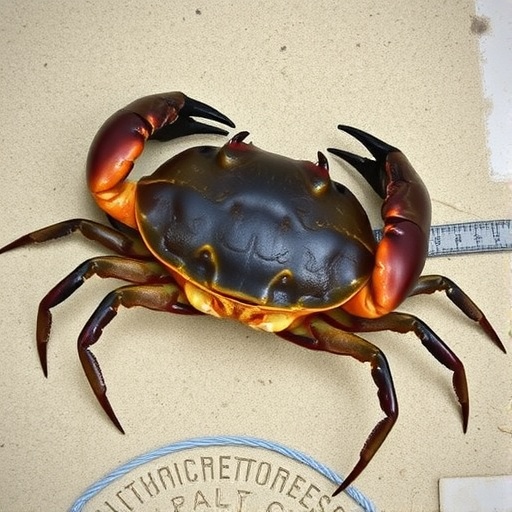The Indian horseshoe crab, scientifically known as Tachypleus gigas, has long survived in the coastal waters, a true testament to nature’s resilience. However, despite its historical and ecological significance, it is classified as data-deficient, meaning that essential information regarding its population dynamics, habitat requirements, and overall biology is sparse. A recent study led by a collaborative team, including researchers Panda, Singha, and Atchuthan, sheds much-needed light on this enigmatic species. Their research, published in Environmental Monitoring and Assessment, unveils crucial ecological insights and conservation strategies specific to the Indian context, particularly along the Odisha coast.
Horseshoe crabs, which are actually more closely related to spiders than to true crabs, play an essential role in marine ecosystems. They serve as a key food source for various birds and marine species, and their presence is indicative of healthy coastal environments. The study highlights the unique ecological niche filled by Tachypleus gigas, noting that its long-term survival is crucial for maintaining the stability of coastal food webs. The researchers were driven by the urgent need to gather ecological data to better inform conservation policies for this little-studied species.
The Odisha coast has emerged as a vital habitat for these horseshoe crabs, serving not only as a breeding ground but also as a refuge for various life stages of the species. These crabs migrate through diverse environments, encompassing estuaries, mudflats, and sandy beaches, each serving specific roles in their lifecycle. The researchers employed field surveys and ecological modeling to gather valuable data on their distribution, reproductive patterns, and habitat preferences, thus contributing significantly to the existing body of knowledge about Tachypleus gigas.
One striking insight from the research is the importance of seasonal variations that influence the breeding cycles of these crabs. The study identified that the horseshoe crab breeding season aligns intricately with specific environmental conditions, such as temperature fluctuations and salinity levels. Understanding this delicate equilibrium is pivotal for ensuring the crabs’ reproductive success, particularly in light of climate change, which threatens to disrupt these established patterns. The findings underscore the necessity for ongoing monitoring of environmental parameters to safeguard the breeding populations of Tachypleus gigas.
The role of human activities along the Odisha coast cannot be understated, as urban development, fishing, and pollution pose significant threats to the horseshoe crab population. The researchers documented instances of habitat destruction driven by human encroachment, which has significant implications for the survival of this species. In light of these findings, the team advocates for the implementation of stringent conservation measures, focusing on habitat preservation, pollution control, and sustainable fishing practices to mitigate human impact.
The collaborative nature of this study highlights a growing trend in ecological research that prioritizes interdisciplinary approaches. The researchers integrated knowledge from marine biology, ecology, and environmental science to create a comprehensive picture of the challenges facing Tachypleus gigas. Collaboration with local communities emerged as a focal point, with researchers emphasizing that the success of conservation strategies hinges on local engagement and education. By involving fishermen and local stakeholders, the project aims to foster a sense of responsibility and stewardship towards the horseshoe crab population and its habitat.
Moreover, the team fashioned actionable conservation strategies, including the establishment of marine protected areas (MPAs) along the Odisha coast. These designated areas would not only serve as sanctuaries for Tachypleus gigas but could also benefit other marine species facing similar threats. The call for MPAs was resonated by the demonstrable success stories from other regions, where the establishment of such zones has led to significant recoveries in marine biodiversity. The researchers call upon policymakers to prioritize the creation of these protective measures without delay.
As the study gained more attention within the scientific community, there emerged a call for further investigation into the genetics and ecology of Tachypleus gigas. Understanding the genetic diversity within populations is crucial for effective conservation planning. Genetic studies could reveal distinct populations along the coastal regions, which might require tailored management strategies. Such research could lead to innovations in conservation techniques and a deeper understanding of the population’s resilience in the face of environmental stressors.
Additionally, the research findings highlight the significance of public awareness campaigns aimed at educating the public about the ecological value of horseshoe crabs. Increasing awareness can galvanize local communities and tourists alike to participate in conservation efforts. Organizations and local authorities could work collaboratively to develop initiatives that highlight the importance of protecting the Indian horseshoe crab and its habitat while promoting sustainable tourism practices.
Finally, the broader implications of the study extend beyond the immediate conservation needs of Tachypleus gigas. The research serves as a model for addressing similar data-deficient species worldwide. By employing a comprehensive methodology that combines fieldwork, local engagement, and robust ecological modeling, the researchers have set a precedent showcasing how collaborative research can produce actionable insights for wildlife conservation. Thus, their findings are not merely about Tachypleus gigas alone but resonate with the global plight of many marine species grappling with the consequences of human activities and environmental change.
In conclusion, the study of Tachypleus gigas shines a light on the intricate interplay between ecological knowledge, conservation efforts, and community involvement. As research progresses, it becomes increasingly clear that our understanding of such vital species is indispensable for formulating effective conservation strategies. The outcome of this ecological inquiry potentially paves the way for more sustainable interactions between human communities and marine ecosystems — ensuring the survival of the Indian horseshoe crab for future generations.
Subject of Research: Indian horseshoe crab (Tachypleus gigas) conservation along the Odisha coast
Article Title: Ecological insights and conservation strategies for the data-deficient Indian horseshoe crab Tachypleus gigas (Müller, 1785) along the Odisha coast, India.
Article References:
Panda, B., Singha, A., Atchuthan, P. et al. Ecological insights and conservation strategies for the data-deficient Indian horseshoe crab Tachypleus gigas (Müller, 1785) along the Odisha coast, India.
Environ Monit Assess 197, 1156 (2025). https://doi.org/10.1007/s10661-025-14564-8
Image Credits: AI Generated
DOI: 10.1007/s10661-025-14564-8
Keywords: Horseshoe crab, conservation strategy, Tachypleus gigas, ecological insights, Odisha coast.




